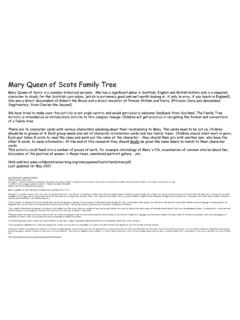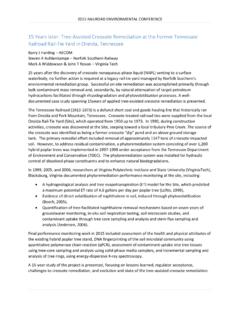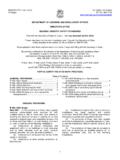Transcription of FAULT TREE ANALYSIS - Defense Technical Information …
1 Ab WftdPjfJi mi in USADACS l Library K 0712 01013405 3 COPY NO ^ ' 1 Technical REPORT 4556 FAULT tree ANALYSIS . WALDEMAR F. LARSEN WA I JANUA JANUARY 1974 i ' i APPROVED FOR PUBLIC RELEASE; DISTRIBUTION UNLIMITED. i I PICATINNY ARSENAL DOVER, NEW JERSEY EEST ARABLE COPY - I The findings in this report are not to be construed as an official Department of the Army Position. 2 . _ Destroy this report when no longer needed. Do not I SECURITY CLASSIFICATION OF THIS PAGE (Whmn Dmlm Entered) REPORT DOCUMENTATION PAGE READ INSTRUCTIONS BEFORE COMPLETING FORM 1. REPORT NUMBER Technical Report 4556 2. SOVT ACCESSION NO. 3. RECIPIENT'S CATALOG NUMBER 4. TITLE (-and Subtitle) FAULT tree ANALYSIS S. TYPE OF REPORT ft PERIOD COVERED 6. PERFORMING ORG. REPORT NUMBER 7. AUTHOROJ Waldemar F. Larsen 8. CONTRACT OR GRANT NUMBERCa) 9. PERFORMING ORGANIZATION NAME AND ADDRESS U. S. Army Picatinny Arsenal, Dover, New Jersey 10.
2 PROGRAM ELEMENT, PROJECT, TASK AREA ft WORK UNIT NUMBERS 1 1. CONTROLLING OFFICE NAME AND ADDRESS 12. REPORT DATE January 1974 13. NUMBER OF PAGES 76 14. MONITORING AGENCY NAME ft ADDRESSfH different from Controlling Olllce) IS. SECURITY CLASS, (ol thle report) UNCLASSIFIED 1S . OECLASSIFI CATION/DOWN GRADING SCHEDULE 16. DISTRIBUTION ST AT EMEN T (ol thie Report) Approved for Public Release; Distribution Unlimited 17. DISTRIBUTION STATEMENT (ol the mbetrmct entered In Block 30. If dltfmrmnt ltom Report) IB. SUPPLEMENTARY NOTES 19. KEY WORDS (Continue on reverse mldm it neceaemry end Identity by block number) FAULT tree ANALYSIS Logic diagram XM813 Safety & Arming device Boolean algebra Block diagram Sensitivity rating Probability Failure mode Reliability Failure mechanism 20.
3 ABSTRACT (Continue on reveree elde II neceeemry and Identity by block number) This report describes the procedure to be used for constructing FAULT trees, the application of Boolean Algebra and the use of probability values in the final algebraic expressions. While not the only method which can be used, the FAULT tree technique is considered to be a very effective analytical tool in assessing system safety. This report supersedes Picatinny Arsenal Technical Report 3822. DD i JAN*73 1473 EDITION OF 1 NOV 65 IS OBSOLETE UNCLASSIFIED SECURITY CLASSIFICATION OF THIS PAGE (When Dmlm Entered) UNCLASSIFIED SECURITY CLASSIFICATION OF THIS PAGEQWian Data Entered) UNCLASSIFIED SECURITY CLASSIFICATION OF THIS PAGE(TWi n Data Entered) FOREWORD FAULT tree ANALYSIS provides a logical method for graphically presenting the chain of events leading to a system failure One result of its application to a system is a mathematical model suitable for determining system safety and reliability from the event probabilities.
4 This handbook is an adaption of Picatinny Arsenal Technical Report 3822 ' FAULT tree ANALYSIS " prepared by Waldemar F. Larsen, and published November 1968 Con- sequently, many of the examples are for fuzes and safety and arming devices The techniques discussed, however, are applicable to any system Since the Technical Report was published and used, some refinement!* of the technique have been made. These refinements comprise a. A clearer distinction between a failure mode and a failure mechanism as applied to FAULT trees. b. A clearer definition of some FAULT tree symbols A new feature of this handbook is a different approach to the quantification of a FAULT tree anlaysis. This approach uses mathematical apportionment of probabilities of occurrence of components given a required end item probability of occurrence CONTENTS Page No. Objectives 1 Abstract 1 Introduction 2 List Successful Events and Requirements 2 Block Diagrams 3 Safety FAULT Trees 3 FAULT tree Construction 4 Failure Modes and Failure Mechanisms 6 Basic Events 7 Use of Boolean Algebra 7 Simplification of the ANALYSIS 7 Examples of Simple FAULT Trees 8 The Probability of Final Event Occurrences 13 Sensitivity Rating 14 Various Means for Selecting Event Probabilities 21 Gross Life Cycle Probabilities 37 Caution in Using Repeat Events 38 Reliability FAULT Trees 40 Relation Between Successful Events and FAULT Trees 40 FAULT tree ANALYSIS for Safety and Arming Device.
5 XM813 43 Description of XM813 S&A Device 43 Sequence of Successful Events 43 Safety Requirements 48 XM813 Safety FAULT tree ANALYSIS 48 Safety Apportionment - XM813 Fuze Armed and Detonator Fires Prematurely in Gun Tube 51 XM813 Fuze Prematures Warhead at Unsafe Distance 63 XM813 Reliability FAULT tree ANALYSIS 65 Distribution List Tables 1 FAULT tree symbols 2 Fundamental equations of Boolean Algebra 3 Complete set of safety FAULT trees 4 Failure mode safety apportionment allowed failures/million Figures 1 Warhead safety FAULT tree 2 Detonator prematures FAULT tree 3 Sensitivity rating through OR gate FAULT tree 4 Sensitivity rating graph through an OR gate 5 Sensitivity rating through AND gate FAULT tree 6 Sensitivity rating graph through an AND gate 7 Parallel system - apportionment through an AND gate 8 Series system apportionment through an OR gate 9 All OR gate events equally liekly 10 XM813 S&A device mounting plate assembly 11 XM813 Schematic 12 Safety FAULT tree 13 XM813 Sensitivity ratio 14 Safety FAULT tree 15 Reliability FAULT tree 68 5 8 36 60 11 12 15 17 18 20 28 31 33 44 45 49 55 64 66 in OBJECTIVES To present a method for analyzing safety and reliability problems through the use of FAULT trees.
6 To present the use of Boolean Algebra to solve the probability combinations of the FAULT tree . To present numerical methods to quantify the FAULT tree ANALYSIS . To present illustrations of FAULT tree analyses. ABSTRACT This report describes the procedure to be used for constructing FAULT trees, the application of Boolean Algebra and the use of probability values in the final algebraic expressions. While not the only method which can be used, the FAULT tree technique is considered to be a very effective analytical tool in assessing system safety. This report supersedes Picatinny Arsenal Technical Report 3822. INTRODUCTION The Greek philosopher, Aristotle, about 330 B. C. made a proposition that a logical statement is either true or false, but never partially true or false. Over 100 years ago, in his book entitled "An Investigation of the Laws of Thoughts," published in London in 1854, George Boole developed a mathematical system involving logic. This system is now called Boolean Algebra.
7 Unlike ordinary algebra variables which can assume an infinite number of values, Boolean Algebra variables can assume only one of two different values. In the middle 1950's Bell Telephone Laboratories started developing the FAULT tree concept by constructing a logic diagram using Aristotle's proposition and Boolean Algebra to express the number of different events which lead to an undesired end event. In 1962 Bell published a report on the Minuteman Launch Control System Safety using the FAULT tree ANALYSIS . Since that time FAULT trees have been used to analyze both safety and reliability of systems whether simple or highly complex. A FAULT tree is a logic diagram based on statements which are either true or false, on or off, open or closed, good or bad, present or absent, etc. The FAULT tree serves to identify the events on an AND/OR basis that contributes to a given final event. The Boolean Algebra is used to express the number of different events (single or combined) which lead to the end event.
8 While not the only method of ANALYSIS , FAULT tree ANALYSIS has been recognized as a powerful analytical tool. For this reason it is hoped that this handbook will acquaint its readers with a working knowledge of FAULT tree ANALYSIS . LIST SUCCESSFUL EVENTS AND REQUIREMENTS Before starting a FAULT tree ANALYSIS it is absolutely essential that the system to be analyzed is thoroughly understood by the analyst. One of the best ways of assuring that the functioning of the system is understood is to list in chronological order the sequence of events leading to success. This list should be complete, omitting no part of the operation. A listing DI I he performance or safety requirements should complement the sequence of successful events. Both of these lists will give a full understanding of the proper functioning and the neeessary requirements for use in making a systematic failure ANALYSIS . BLOCK DIAGRAMS The sequence of successful events list is given in narrative form.
9 From this list, a block diagram for successful events is made. Within each block is given the terse description of one event. The description will consist of a subject, a verb and some- times an object. The blocks will be joined together in series or parallel or a combination of the two according to the functioning of the system. The method of constructing a block diagram is best understood by studying the diagrams of the examples given on pages 44 through 68. SAFETY FAULT TREES A safety FAULT tree identifies the various sequence of events that will result in an item malfunction which endangers friendly personnel and/or material. Before drawing a FAULT tree , select the malfunction (safety or reliability) to be investigated. An item may fail in several different ways, so it is essential that a FAULT tree clearly state the situation under investigation. For example, a fuze may detonate prematurely, usually the most serious case, or the munition may leak explosive, creating a fire hazard.
10 Regarding reliability, the munition may be a dud, miss the target, or function at the wrong time. Each of the different waysan-TtWunav fgiHrijiifferent configurations, or different phases of the life cycle may reqjuirqa/spparattffault tree . While these FAULT trees may be similar, they will vary in the significant contributing events, and it is these variations which make the FAULT tree ANALYSIS such a powerful tool. To emphasize this very important point, consider (a) a fuze prematures prior to assembly to the warhead (b) a fuze prematures the warhead in the launcher versus (c) a fuze prematures the warhead at unsafe short distance downrange. For situation (b) (premature in launcher) one branch of the FAULT tree states that the rotor must be prearmed, which aligns the explosive train, while the other branch states that the detonator must fire prematurely with the most likely cause being a short circuit to the detonator so that when the missile battery is activated, the "blow" is immediate.

















